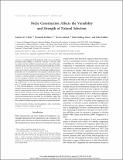Files in this item
Niche construction affects the variability and strength of natural selection
Item metadata
| dc.contributor.author | Clark, Andrew D. | |
| dc.contributor.author | Deffner, Dominik | |
| dc.contributor.author | Laland, Kevin | |
| dc.contributor.author | Odling-Smee, John | |
| dc.contributor.author | Endler, John | |
| dc.date.accessioned | 2020-01-22T11:30:01Z | |
| dc.date.available | 2020-01-22T11:30:01Z | |
| dc.date.issued | 2020-01 | |
| dc.identifier | 265915165 | |
| dc.identifier | 46aac906-923e-400a-8f88-53054b9872c4 | |
| dc.identifier | 85076681366 | |
| dc.identifier | 31868536 | |
| dc.identifier | 000508259300004 | |
| dc.identifier.citation | Clark , A D , Deffner , D , Laland , K , Odling-Smee , J & Endler , J 2020 , ' Niche construction affects the variability and strength of natural selection ' , American Naturalist , vol. 195 , no. 1 , pp. 16-30 . https://doi.org/10.1086/706196 | en |
| dc.identifier.issn | 0003-0147 | |
| dc.identifier.other | ORCID: /0000-0002-2457-0900/work/67919210 | |
| dc.identifier.uri | https://hdl.handle.net/10023/19332 | |
| dc.description | Research was supported in part by a grant from the John Templeton Foundation to K.L., J.O.-S., and J.E. (“Putting the Extended Evolutionary Synthesis to the Test”; grant 60501). | en |
| dc.description.abstract | Consideration of the properties of the sources of selection potentially helps biologists account for variation in selection. Here we explore how the variability of natural selection is affected by organisms that regulate the experienced environment through their activities (whether by constructing components of their local environments, such as nests, burrows, or pupal cases, or by choosing suitable resources). Specifically, we test the predictions that organism-constructed sources of selection that buffer environmental variation will result in (i) reduced variation in selection gradients, including reduced variation between (a) years (temporal variation) and (b) locations (spatial variation), and (ii) weaker directional selection relative to nonconstructed sources. Using compiled data sets of 1,045 temporally replicated selection gradients, 257 spatially replicated selection gradients, and a pooled data set of 1,230 selection gradients, we find compelling evidence for reduced temporal variation and weaker selection in response to constructed compared to nonconstructed sources of selection and some evidence for reduced spatial variation in selection. These findings, which remained robust to alternative data sets, taxa, analytical methods, definitions of constructed/nonconstructed, and other tests of reliability, suggest that organism-manufactured or chosen components of environments may have qualitatively different properties from other environmental features. | |
| dc.format.extent | 15 | |
| dc.format.extent | 6004049 | |
| dc.language.iso | eng | |
| dc.relation.ispartof | American Naturalist | en |
| dc.subject | Natural selection | en |
| dc.subject | Niche construction | en |
| dc.subject | Selection gradients | en |
| dc.subject | Spatial | en |
| dc.subject | Strength of selection | en |
| dc.subject | Temporal | en |
| dc.subject | QH301 Biology | en |
| dc.subject | Ecology, Evolution, Behavior and Systematics | en |
| dc.subject | DAS | en |
| dc.subject.lcc | QH301 | en |
| dc.title | Niche construction affects the variability and strength of natural selection | en |
| dc.type | Journal article | en |
| dc.contributor.sponsor | John Templeton Foundation | en |
| dc.contributor.institution | University of St Andrews. Centre for Biological Diversity | en |
| dc.contributor.institution | University of St Andrews. Scottish Oceans Institute | en |
| dc.contributor.institution | University of St Andrews. Institute of Behavioural and Neural Sciences | en |
| dc.contributor.institution | University of St Andrews. Centre for Social Learning & Cognitive Evolution | en |
| dc.contributor.institution | University of St Andrews. School of Biology | en |
| dc.identifier.doi | https://doi.org/10.1086/706196 | |
| dc.description.status | Peer reviewed | en |
| dc.identifier.grantnumber | 60501 | en |
This item appears in the following Collection(s)
Items in the St Andrews Research Repository are protected by copyright, with all rights reserved, unless otherwise indicated.

